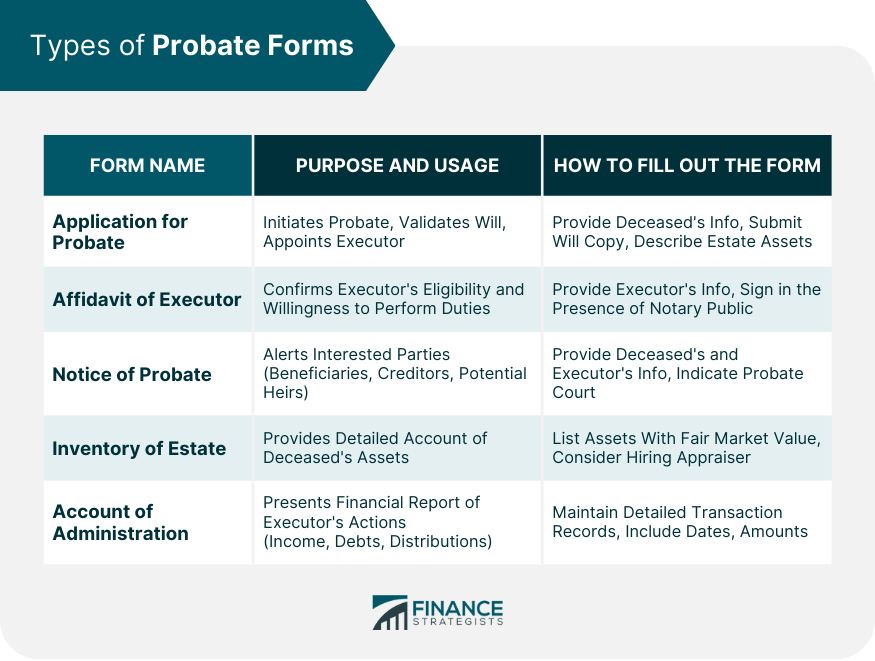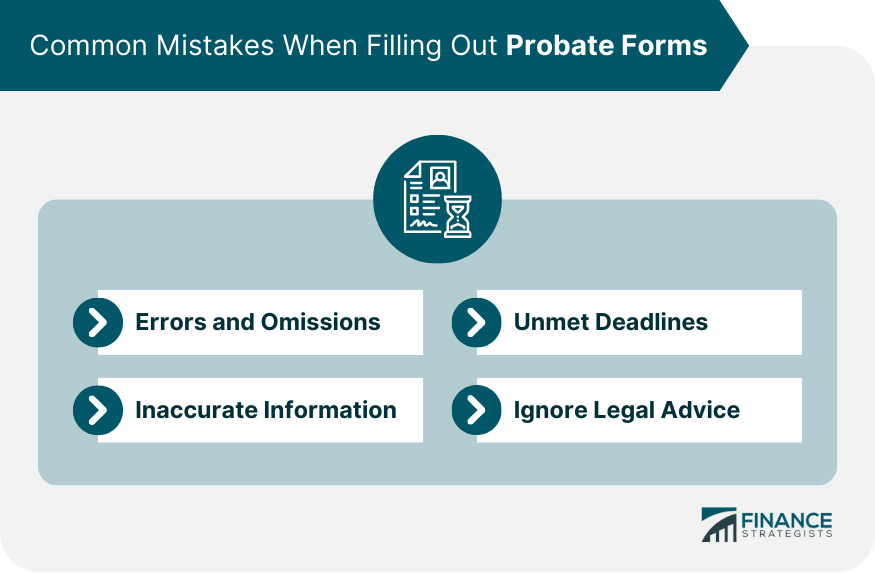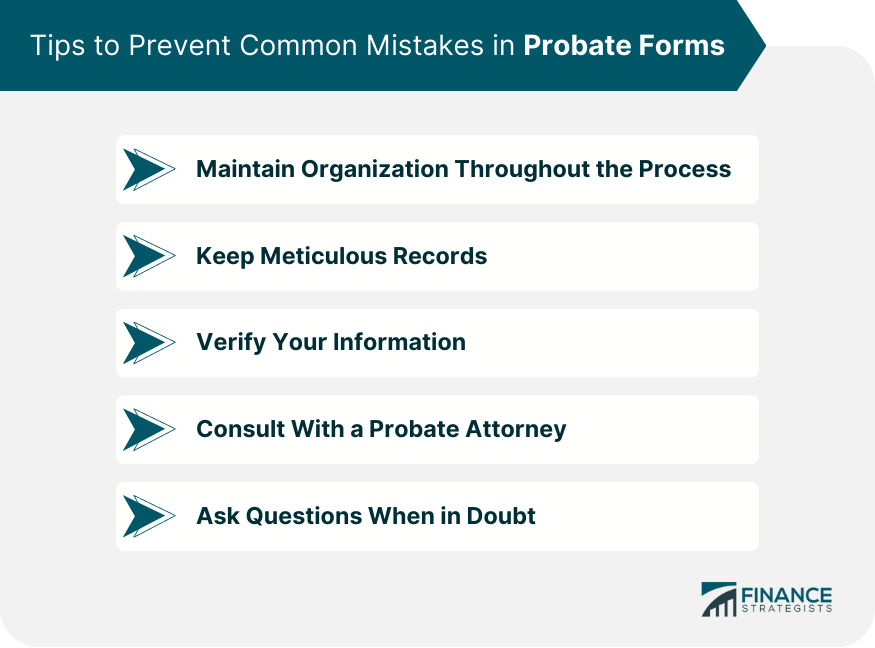Probate is a legal process through which the estate of a deceased individual is administered. This process includes identifying, cataloging, appraising, and distributing the deceased's assets in accordance with the will, if one exists, or state laws if there isn't a will. Probate is conducted by an executor or administrator appointed by the deceased or appointed by the court if none was designated in the will. Probate forms are official documents used in the probate process. These forms serve as a formal tool of communication between the executor/administrator, the court, the beneficiaries, and any creditors. They differ depending on the jurisdiction and the specific estate administration tasks. Probate forms are required when a deceased individual leaves behind assets not transferred via joint ownership or beneficiary designations. These forms allow courts to monitor the executor's performance and document their actions, providing a structured way to conduct the probate process. The Application for Probate, also known as Petition for Probate, is the initial form submitted to the probate court to start the probate process. It requests that the court recognize the will as valid and appoint the proposed executor. To complete the Application for Probate, you'll need the deceased's full legal name, date of death, and address. You'll also need a copy of the will and information about the named executor. The form usually requires a description of the estate's assets and their estimated value. The Application for Probate is generally filed in the probate court in the county where the deceased lived at the time of death. The filing must typically occur within a certain timeframe after the individual’s death, often 30 days. The Affidavit of Executor is a sworn statement made by the proposed executor confirming their willingness and eligibility to perform the role. It often includes a declaration that the executor will perform their duties faithfully. The form usually requires the executor's full name, address, and signature. The executor must swear or affirm that the information they've provided is true. This usually takes place in the presence of a notary public. This affidavit is typically filed with the probate court alongside the Application for Probate. The Notice of Probate alerts interested parties that probate has begun. Parties can include beneficiaries named in the will, known creditors, and in some cases, potential heirs if no will exists. This form often requires the name and address of the deceased, the executor's name and contact details, and the court where the probate is taking place. After completion, this form is sent directly to interested parties. Proof of delivery, often through certified mail, is then filed with the court. The Inventory of the Estate provides a detailed account of the deceased’s assets. This includes real property, personal property, bank accounts, and other assets. On this form, list all the deceased's assets, along with their fair market value at the time of death. You may need to hire an appraiser for valuable items or real estate. This form is usually submitted to the probate court within a few months after the executor's appointment. The timing may vary based on local rules. The Account of Administration provides a full financial report of the executor’s actions. This includes any income the estate received, bills and debts paid, and distributions to beneficiaries. The form requires detailed records of all financial transactions related to the estate. This includes the date, amount, purpose of each transaction, and remaining balance of the estate. The Account of Administration is submitted to the probate court as part of the closing process. The timing will vary depending on the complexity of the estate and local rules. Various forms may be required depending on your state or country's law. These could include a form for releasing assets to the beneficiaries or a form for closing probate. Each form has its purpose, usage, and instructions for completion. Always check with your local probate court to ensure you're using the correct and most current forms. One common mistake in filling out probate forms is errors and omissions. A misspelled name, an overlooked asset, or an inaccurate value can lead to legal complications. To avoid this, ensure you double-check all your entries and have a second set of eyes review the forms. Providing inaccurate information, whether intentional or not, can also cause complications. If you're unsure about certain information, don't guess. Instead, seek the correct information from reliable sources. Not meeting deadlines is another common mistake. Late submissions can delay the probate process and potentially result in penalties. Be aware of all deadlines and plan accordingly to ensure forms are filed on time. Probate can be a complex process, and ignoring legal advice can lead to mistakes. It's always wise to consult with a legal professional to understand your obligations and responsibilities better. To ensure nothing falls through the cracks, keep all documents neatly organized. Develop a filing system that works for you - this could be digital, paper-based, or a combination of both. Keeping track of all these materials will help you prevent mistakes and allow you to easily reference necessary information. In conjunction with staying organized, keeping meticulous records is crucial. This includes not only maintaining copies of filled-out forms but also keeping track of all transactions related to the estate. Record every asset sale, bill payment, and distribution to beneficiaries. Additionally, maintain records of any communication relevant to the estate. Detailed records can help you accurately complete forms and provide a clear account of your actions as executor if questioned by the court or beneficiaries. Before submitting any form, always verify the information you've included. Confirm asset values, double-check names and addresses, and ensure all information aligns with what's included in the will and other supporting documents. This step can help you avoid errors and omissions that could complicate the process. Probate attorney can explain legal terms, help you understand your duties and deadlines, and provide counsel if legal issues arise. While hiring an attorney involves costs, it can often save time, prevent serious mistakes, and provide peace of mind. If you're ever unsure about something, don't hesitate to ask questions. Whether you're questioning a legal term on a form or unsure about a particular step in the process, it's better to seek clarification than to make an incorrect assumption. Probate court clerks, legal help centers, or your probate attorney can be good resources for your questions. Probate forms are fundamental to the probate process, serving as an official record of all actions taken in the administration of a deceased's estate. From the Application for Probate to the Account of Administration, each form carries its unique purpose and requirements, informing and recording the executor's duties at every stage of the process. The importance of accuracy, timeliness, and adherence to all legal guidelines cannot be overstated, given the potential for complications arising from errors or omissions. As complex as the probate process may seem, it is manageable with careful attention to detail, organization, record-keeping, and the pursuit of legal advice when needed. It also emphasizes the importance of asking questions whenever uncertainties arise. Ultimately, the probate process is not just about fulfilling a legal obligation; it's a responsibility to carry out the final wishes of the deceased and to ensure a smooth transition of assets to the beneficiaries.Overview of Probate Forms
Detailed Guide to Types of Probate Forms
Application for Probate
Purpose and Usage
How to Fill Out the Form
Where and When to Submit
Affidavit of Executor
Purpose and Usage
How to Fill Out the Form
Where and When to Submit
Notice of Probate
Purpose and Usage
How to Fill Out the Form
Where and When to Submit
Inventory of Estate
Purpose and Usage
How to Fill Out the Form
Where and When to Submit
Account of Administration
Purpose and Usage
How to Fill Out the Form
Where and When to Submit
Other Relevant Forms

Common Mistakes When Filling Out Probate Forms
Errors and Omissions
Inaccurate Information
Unmet Deadlines
Ignore Legal Advice

Tips to Prevent Common Mistakes in Probate Forms
Maintain Organization Throughout the Process
Keep Meticulous Records
Verify Information
Consult With a Probate Attorney
Ask Questions When in Doubt

Bottom Line
Probate Forms Guide FAQs
A probate forms guide is a resource designed to help you understand the various forms required in the probate process, their purpose, and how to fill them out.
A comprehensive probate forms guide can often be found on the website of your local probate court or through legal advice centers.
A probate forms guide is needed to help you navigate the legal process of probate, ensuring you fill out and submit the correct forms at the right time.
Yes, a probate forms guide can help you understand common mistakes and provide tips to avoid them.
No, probate laws and the required forms can vary from state to state. It's essential to find a probate forms guide specific to your jurisdiction.
True Tamplin is a published author, public speaker, CEO of UpDigital, and founder of Finance Strategists.
True is a Certified Educator in Personal Finance (CEPF®), author of The Handy Financial Ratios Guide, a member of the Society for Advancing Business Editing and Writing, contributes to his financial education site, Finance Strategists, and has spoken to various financial communities such as the CFA Institute, as well as university students like his Alma mater, Biola University, where he received a bachelor of science in business and data analytics.
To learn more about True, visit his personal website or view his author profiles on Amazon, Nasdaq and Forbes.











